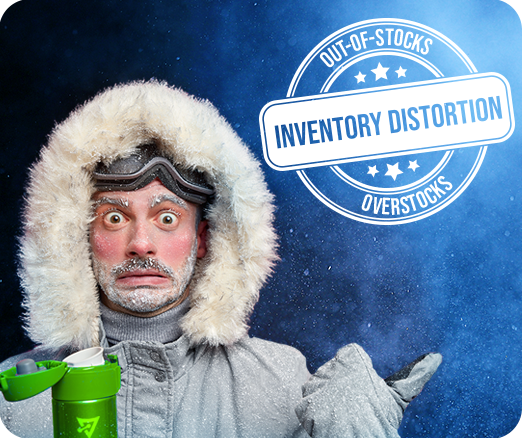
Need a Shelter in Stormy Inventory Weather?
It’s a volatile and uncertain time for consumer packaged goods (CPG) companies.
CPGs are facing a slew of issues—from post-pandemic supply chain disruptions and inflationary pressures to increased competition for shelf space and difficulties identifying consumer demand patterns. The stormy weather is making demand forecasting and planning, along with meeting consumer demand, harder than ever as CPGs struggle to strike the optimal inventory balance, a challenge that is both art and science. This conundrum has left many weighing the risk of stockouts (missed sales) against the gamble of excess stock (high holding costs).
Fortunately, there is a way to steer safely through the storm into the sunshine.
The Heavy Winds of Stockouts
Out-of-stocks (OOS) can spell disaster for CPGs, as well as retailers, in both the short- and long-term. In the short-term, there are lost sales and frustrated consumers. When shopping in-store and facing stockouts, 21% of shoppers will leave and buy from a competitor’s store—and possibly buy a competitive product.
The long-term outlook can be even more threatening, leading to decreased profit margins, lower customer satisfaction, damaged brand reputation, and sales permanently going to competitors instead.
Stockouts are usually the result of inaccurate inventory data, human error from manual processes, poor shelf-replenishment practices, and late deliveries.
Recent data from the National Bureau of Economic Research shows that stockouts reached up to 20% in 2021. According to one report, consumers today encounter at least one OOS item during one of every five trips to a food, drug, or mass merchandise store. In 2021, the CPG industry—while sustaining growth—lost 7.4% of sales from OOS, which cost retailers $82 billion.
The simple solution to preventing lost sales and revenue is to keep items in stock and on shelves. The question is: Do you have the best data from both the shelf, store, and warehouse levels to give you the insights to make successful stock decisions? The answer is no if you find yourself reacting to OOS instead of preventing them in the first place.
The Pouring Rains of Inventory Glut
For some, replacing just-in-time inventory with just-in-case goods has resulted in an inventory glut, drastically reducing operating margins. Over-buying during the pandemic served as a logical solution to mitigate supply chain kinks, but it has come with a price.
Too much inventory ties up capital, which could be used instead for reinvesting in the supply chain, for sales and marketing, and for operational efficiencies. Headaches from excess and obsolete inventory can include:
- A delay of available working capital
- Products marked down at extreme discounts
- Brand tarnish, since lower-priced goods can be perceived as lower quality
- Warehousing costs to hold the inventory
- Transshipment costs if product needs to be moved
- Disposal costs for products that never sell
While markdowns can help to clear up excess inventory, they hurt the bottom line.
These issues underscore the need for better demand forecasting and planning, including a proper demand-driven supply chain, along with optimized retail replenishment.
But—regarding what consumers are looking for or no longer interested in—when the data is not there or at least not clear, how can one determine effective inventory management processes and execution strategies for steps such as pre-season planning and pricing? Add challenging market conditions and unpredictable consumer behavior, and the outlook is even foggier.
Gloomy Forecasts: Inventory Distortion
The cumulative impact of lost sales from OOS and deep discounts required to sell overstocked items is known as inventory distortion. The cost last year to North American retailers across the CPG industry was $349 billion. Recent estimates put the total amount of lost revenue opportunities worldwide from inventory distortion at more than $1 trillion.
One of the main culprits of inventory distortion is disconnected, disparate, and incomplete data—and a lack of visibility into data. The problem is that it can take a long time and numerous resources to gather the right data and then correct and rebalance inventory. And time is money.
The pressures are worse for those brands that still lean on legacy systems and the same manual, time-consuming, and painstaking processes from years ago. These error-prone approaches often lack historical insights and current, near-real-time demand and supply chain data to drive strategic decisions and take immediate action. Excel spreadsheets and judgment calls can lead to poor planning and execution, as well as lost sales, consumer loyalty, and retailer trust. The old foundations and methods just don’t hold water anymore.
Here Comes the Sun
Getting the right product to the right place at the right time may not be easy, but it is necessary. Failure to deliver when consumers are poised to buy is a fast-track to the bottom. But there is help available that can guide you through these storms and push the clouds away.
Retail Velocity understands that having granular supply and demand data and analytics, with deeper insights to achieve the right inventory balance to operate efficiently and profitably, is paramount. As consumer demand shifts, VELOCITY®, the best-in-class retail POS and inventory data reporting and analytics platform, enables your business teams to quickly identify key insights in sales, inventory, forecast, order, and shipment data to adapt smarter and optimize sales and inventory to meet demand at the physical and digital shelf.
With over 25 years of experience and expertise in aggregating, cleansing, and harmonizing item- and store-level retail POS data with enterprise data, we provide the most reliable retail data and analytics solutions so you can make more-informed decisions today that drive sales tomorrow—across all your retailers.
Spending less time wrangling and wrestling data gives you more time to develop and leverage meaningful insights. And here’s the result: data-driven decisions that influence retailers to put your products on the shelf, keep them there, and view you as the authority for sales insights and answers that will make you and your retailers more profitable.
It’s time for a comprehensive solution that addresses the full complexity and scale of the modern CPG industry. It’s time to optimize inventory using an end-to-end view of your supply and demand chain and get your products on the right shelf when your customers want and need them. It’s 2023, and time is up for giving shoppers a reason to switch brands.
The silver lining is that demand continues to boom for consumer packaged goods. According to MarketWatch, the global CPG market is expected to rise at a significant rate between 2023 and 2028.
But if you want to reach new sales horizons and see brighter, more profitable skies, ensure your inventory management strategies, decisions, and success are sheltered and supported by the most precise data and valuable insights.
Contact us today to learn more about how you can protect your profits.



